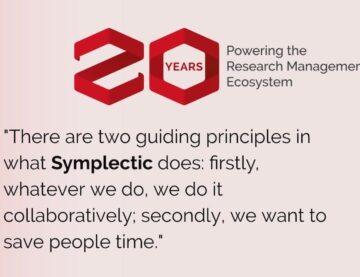Subscribe to our newsletter
#FoundersFriday with John Fearns from Symplectic
We are very excited to bring you a new interview for our #FoundersFriday blog series! If you’ve missed our previous posts, Founders Friday is a platform in which we interview the founders of different scholarly communication businesses, asking them to share their advice for others and their perspective on the industry as a whole.
For this edition we have interviewed John Fearns (@johnfearns), Co-Founder of Symplectic, the world’s leading Research Information Management System, which helps institutions capture, analyze and showcase their research.
Sympletic’s main aim is to reduce the administrative burden on researchers, in order to help them get on with doing what they want to do – research. They also provide software and services that help institutions understand their research collaboration networks. Their software is used around the world by over 80 institutions and 300,000 researchers, and they’re still growing – last year they were featured in a short film by the Telegraph’s Business Club.
Created in 2003 by four friends studying for their PhDs, Symplectic has now grown into a successful international business, with over 30 employees spanning 3 continents – but it still retains the cultural feel of a startup.
Symplectic is part of the Digital Science group of companies, all working towards making research smarter, more collaborative, and more efficient. Sympletic work in an open plan office in close proximity to the rest of the group, and often work together to integrate various products.
What made you decide to leave academia and launch your own business idea?
Those were two independent decisions. I didn’t particularly enjoy my PhD topic, and after a year or so, I knew I was going to leave academia. The main reason being – theoretical physics can get quite lonely! Collaborating with colleagues, focusing on real world tasks and sharing the success is a way of working I much prefer. But, even after I decided not to pursue academia, I did make an effort to finish my PhD.
At the time, Daniel Hook – Digital Science’s Managing Director, myself, and the two other Founders of Symplectic, were all officemates. The four of us would lock ourselves in our office and discuss physics all day!
During the third year of our PhDs, Daniel was doing a lot of IT work – mainly for Imperial College – to pay for his PhD, which was part time. He is a man who makes promises to people – which is great for business, but one day he promised a little too much and he turned to us and said that he needed some help. We were already computing enthusiasts with skills in programming so we thought why not! The rest, as they say, is history. Soon we were making a living out of it.
How did you arrive at Sympletic?
By more or less, an accident. We all knew academics – Daniel in particular – that were frustrated with the IT solutions they had. We were essentially improving them, writing different products, and through a process of trial and error, and after around ten different projects, the one that really took off turned out to be Elements.
If you could go back in time and give your pre-startup self one piece of advice, what would it be and why?
If I was to give my younger self some advice, it would be to chill out and relax a bit more!
Suppose I have an idea for a tool, or a solution for a problem within the research landscape and I want to develop my idea into a business. What would your advice to me be?
By far the most important bit of advice I can give is to make sure you’re solving an actual problem, rather than presuming there is one. When people cling onto ideas they have a lot invested in, emotions get in the way and you can lose sight of day to day survival. Success comes when you make someone else smile! Right from a product’s initial development, focus on generating an income from your idea – if you’re not doing that, then you are potentially handicapping yourself.
Who to approach? For me, someone who can sell. I deliver solutions to problems someone has identified; I ended up here because at university I happened to surround myself with lots of individuals with different talents. Talk to Daniel to find out how he surrounded himself with potential customers. He used a simple rule of thumb: be extremely helpful to those who could later give you paid work.
As the founder of a business, what are you proudest of?
The culture surrounding Symplectic. The people I work with have a can-do attitude – we’re all in it for the same reasons. Creating that atmosphere is what I’m most proud of.
In the scholarly communication & publishing space, it’s often said that people have the same conversations again and again. Can you think of an issue that, in your view, people aren’t talking about enough?
That’s an interesting question which is best answered by looking outwards – what problems are we trying to solve business wise? I tend to focus internally, so I’ll give you an answer to a question that you might not expect: what do people not talk about enough when developing software in general?
They don’t talk about the long-term. Software developers move fast– very fast. The culture in software product development is increasingly short-term, things like the Agile movement have amazing benefits, but it is ultimately a short-term philosophy – teams put themselves in real danger of not looking after the foundations of their product. You have to focus on your customers’ needs – attempt to create a balance between the daily needs and the long-term goals of a business.
How can you envision the landscape of scholarly communication changing? Are they going to be more and more people working in this space? If so, how will people and institutions decide what the best tools are to use?
Major changes will be, primarily, in the spread of unique identifiers. Identifying things that we are all interested in is enormously important. For instance, ORCID ids used to identify researchers, and DOIs for publications were invented quite a long time ago and we’ve all seen how useful those things are!
I think the spread of agreements about how you identify things will change. It sounds a little dry, but people get very excited about them in practice. As I said before, you only need to look at unique identifiers to see why that is. The more those kinds of things exist – the easier our job is to do, and the easier it is to understand what your institution is doing in research.
In the next few years, more tools will be created, how are customers going to pick tools that suite them best?
Customers pick tools that ease pain or save time when doing repetitive tasks. So if you are a researcher that would like to collaborate on a paper, but the other researcher is on the other side of the world, you might want to look at tools that allow you to collaborate in real-time – like our sister company Overleaf, which has developed a writing, collaborating and publishing tool used by 400,000 authors across the globe. It’s really about the pain points of day-to-day academia or university management. Go to a university and ask the academics and librarians what work they want to do versus what work they have to do. They’re going to be willing to pay for solutions that reduce the work they have to do!
With Elements, it began with helping academics tell their university what they’re doing; you don’t want to be spending all day filling out sheets when you can click a button and do it in two minutes – that’s exactly where (and why) we entered the market.
What does the future have in store for Symplectic?
We’ll carry on working closely with our user community and develop with their needs in mind. There are plenty of different needs. So, the future will inevitably bring change, and while our plans may evolve as time goes on, we do know that there are many exciting things in store for Symplectic.
One of the most exciting areas is in supporting the Open Access movement. We have already done a lot to help research institutions implement their own Open Access policies, and I’m sure we’ll do much more.




